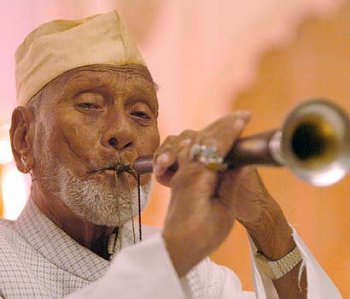
|  |

|  |
The story of the Shehnai through the eyes of Rita Ganguli - Shanta Serbjeet Singh, New Delhi e-mail: shanta.serbjeetsingh@gmail.com September 1, 2010 Rita Ganguli, the eminent, multi-faceted musician and theatre artiste who got instant fame after singing the memorable Baiji thumri in the mujra wedding scene in Parineeta has never stopped to rest on her laurels. The knowers have always known that her life-long commitment to the arts, from that of the thumri to the ghazal to the many theatre and dance forms that we have, goes way beyond her long tutelage with two masters, Siddheshwari Devi and Begum Akhtar. Also her personal life, from a childhood spent in a very musically aware family of Calcutta and Shantiniketan, to her relationship with a founder of the renaissance of Indian performing arts, Keshav Kothari, the former Secretary of the Sangeet Natak Akademi and her husband. A senior Professor at the National School of Drama for classical theatre most of her working life, she is an avid student and practitioner of classical dance, both the Northern Kathak and the southern Kathakali. Some years ago, she wrote the first biography of Bismillah Khan. She has now followed it up with a technical monograph on the instrument which was long considered the preserve of the "achoot," the one who must not be 'touched.' Hence the 'untouchable.' The earliest musical instrument, muses Rita, must have been the one which came to man through nature. That is the Shankh, the conch, drawn from the womb of the primordial oceans. This is an instrument which has been associated with all auspicious occasions in Hindu households and continues to be a part of every temple ritual. Similarly, another wind instrument which is played through the lips, by blowing into the instrument, is the bansuri, the flute, fashioned from the baans, the bamboo plant, an instrument which is as much a part of the image of Lord Krishna, the divine flute player as his peacock crown. The third wind instrument is the Shehnai, again associated with every festival, marriage, sacred thread ceremony, birth ceremony, in short everything where the presence of the 'samaj,' the society, is sought.  When chance took the infant Bismillah (he was then all of three) to the ustad, his mother's brother, one festive Eid season, it was he who recognised the child's exceptional musical talent. He insisted the sister leave him behind and allow him to groom the child into playing the shehnai, his instrument. The mother was at first reluctant to leave the child with him. It wasn't just the toddler's age which deterred her. She was acutely aware of the lowly position that a shehnai player had in society. Not only that. Even the professional musicians would not allow a shehnai player to enter their homes. The place for a shehnai player was strictly at the gate, invariably outside the courtyard. Rita recounts that they would not be provided with any proper durry, let alone a carpet, to sit upon. A few hessian cloth old sacks would be provided for the musicians, since the sacks could be thrown away after the performance. The shehnai player was firmly an 'untouchable' whose business was to herald the auspicious occasion for which he was hired by making music. Do that and then disappear, he was told! It was from this state of affairs that Ustad Bismillah Khan lifted the shehnai and gave it a place in the sun. The prestige and honour that he bestowed on this lowly instrument took it to such great heights that on the historic occasion of 15th August 1947, the first musician to go on the air in Akashvani Bhavan, was Ustad Bismillah Khan. He wove the notes of Raag Lalit into the fabric of a new culture and a democratic and equitable India was born. For the past seventy-five years, practically all national occasions associated with the country's celebrations have put the shehnai under the arc lights. And while he was still able to perform, it was always Ustad Bismillah Khan. They have been automatically associated with his unparalleled musical expressions through gramophone records, live performances and now through cassettes and CDs. Born in Bihar in 1916 in Dumraon of Shahabad Dist. he was the fourth generation of traditional shehnai players. His father Rasool Baksh Khan was the state musician of the court of Bhojpur. At the age of three, when the baby Bismillah was taken to celebrate Eid with his mother's brother, Ustad Ali Baksh, known as Chhote Mamu, came the big turning point in his life mentioned earlier. Ustad Ali Baksh was employed in Jadau Mandir, to play the shehnai every day, with the early morning temple service, in the afternoon and evening worship and again, at night. He was paid a salary of four rupees, a very big amount in those days. He was given a room for his daily riyaz (practice) in the Balaji temple. Four times a day, young Bismillah would invariably follow Mamu to every concert. While he would listen with rapt concentration to the concerts, in Mamu's practice time he would hum the tunes alongside, even as he played with marbles. Each throw of the marble would be timed by him to arrive at the sama, the pivotal beat at which the time cycle starts. This surprised Ali Baksh, who observed that his nephew had perfect sense of tune and timing. When time came for Bismillah's mother to go back to Dumraon, Ali Baksh insisted that the young boy should be left with him to be trained as a musician. In that moment of her decision lay the fate of not just little Bismillah but of the story of the shehnai! There is hardly any music conference or any official function where Khan Saheb did not inaugurate the event with his shehnai. He represented India throughout the world and also received all the awards that include Sad Bhavana award, Fellowship of the Sangeet Natak Akademi, and finally the Bharat Ratna. Khan Sahab may be the only musician whose funeral was telecast by all the channels and it was declared a State mourning. Appropriately, the National Academy of Music, Dance and Drama now gives awards to young brilliant artists in all categories in the name of the Ustad Bismillah Khan Yuva Puraskar. An interesting aside: Khan sahab was a staunch Muslim. He did not miss a single namaz throughout his life. He kept fast throughout the month of Ramzan. Every Moharram, Khan Saheb would lead the procession of the Tajia playing on his specially made silver shehnai. And yet he was a true secular at heart, his intuitive understanding of the secular 'tehzeeb' of his land is illustrated by a true life incident in which an American millionaire expressed interest in taking Khan Saheb to America. Bismillah declined the offer saying that he could not leave his Ustad's house in Varanasi. The gentleman offered to transport the entire house with the earth around it to America. Khan sahab smiled and asked: "Can you transport the Ganga river and the sound of the temples bells? I cannot make music without them." Rita recalls: "Throughout his life, Khan Saheb led a very simple life. He did not allow a single table fan in his house. When I visited Khan Saheb's house as a research scholar, he took me to his room on the second floor and showed me a scene through the window which I will never forget. There was a young mother sitting under the scorching sun in the month of June. She was rocking her new born baby in an improvised torn cloth swing and she was humming a lullaby. Khan sahab told me that this was the kind of expression that he liked to bring into his music. "My music must represent our common people. Their joy, anguish and pain must be reflected in my music." Truly Khan saheb was a Bharat Ratna.  Shanta Serbjeet Singh, for twenty-five years, columnist, critic and media analyst for The Hindustan Times, The Economic Times and The Times of India, is the recipient of the Lifetime Achievement Award of the Sangeet Natak Akademi and Delhi Govt.'s Sahitya Kala Parishad for her contribution to the field of culture. She just finished her term as Vice Chairman of the SNA, is the founder-secretary of the World Culture Forum and continues as Chair of the UNESCO created NGO APPAN (The Asia-Pacific Performing Arts Network), a position to which she was appointed in 2001. Singh has authored several well-known publications such as 'Indian Dance: The Ultimate Metaphor' (published by Ravi Kumar (Paris), 'The 50th Milestone: A Feminine Critique' (Sterling Publishers, to mark India's fiftieth anniversary of Independence), 'Nanak, The Guru' (Oxford University Press) and 'America and You' (22 editions). |